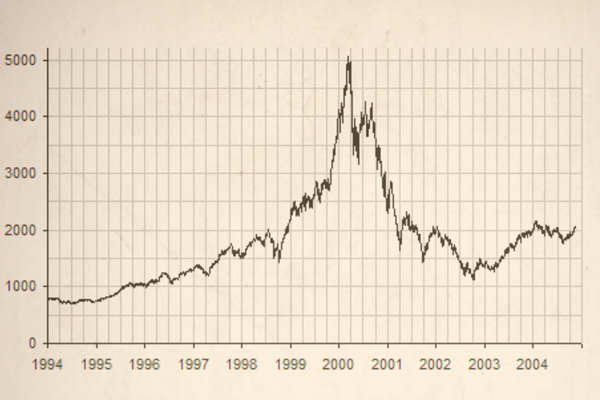“NASDAQ IXIC – dot-com bubble small” by Made by ed g2s • talk. is licensed under CC BY-SA 3.0.
Twenty-five years ago, on March 10, 2000, the tech-fueled Nasdaq Composite soared to an all-time high of 5,048.62, marking the apex of the dot-com boom. It was a moment of euphoric optimism, a testament to the rapid rise of internet-based businesses and the unshakable belief that the web would transform every aspect of life.
But as we now know, that record-setting day was the turning point before a dramatic collapse. Within months, the bubble burst, wiping out trillions in market value and reshaping the tech sector forever.
The Rise: A Digital Gold Rush
The late 1990s were a time of unparalleled excitement in the tech world. The internet, once a niche academic and military tool, had exploded into mainstream consciousness.
Companies like Amazon, Yahoo, eBay, and Pets.com captured investors’ imaginations, promising to revolutionize commerce, communication, and media. Venture capital flooded the sector, and startups with little more than a business plan and a “.com” in their name saw skyrocketing valuations. Fueled by cheap capital, an IPO frenzy, and the belief that profitability was secondary to growth, Nasdaq soared over 500% from 1995 to early 2000.
Tech was the new frontier, and everyone wanted in. From day traders to institutional investors, the market seemed unstoppable, until reality set in.
The Fall: When the Bubble Burst
In the months following the Nasdaq’s peak, cracks in the foundation became impossible to ignore.
Many startups, despite their soaring valuations, were hemorrhaging cash with no clear path to profitability. As interest rates rose and investors became more cautious, the sell-off began.
By the end of 2002, the Nasdaq had plummeted nearly 80%, erasing nearly $5 trillion in market value. Countless dot-com startups vanished overnight, venture capital dried up, and companies once hailed as industry leaders shuttered their doors.
Even giants like Amazon and Cisco saw their stock prices collapse, though they ultimately survived and thrived in the long run.
The Wrap
The dot-com boom and bust taught hard lessons about speculation, market cycles, and the need for sustainable business models. But it also paved the way for the modern internet economy. Many of today’s biggest tech firms, Google, Facebook (Meta), and even a resurgent Amazon, benefited from the infrastructure, innovation, and talent born in that era.
As we look back 25 years later, the Nasdaq’s 2000 peak is more than just a historical data point, it’s a reminder of both the risks and rewards of technological revolutions. Today’s markets, shaped by AI, blockchain, and next-gen computing, may face their own bubbles.
But the legacy of the dot-com era lives on, proving that while booms and busts are inevitable, true innovation endures.
Go Deeper –> Dot-Com Bubble Peaks Out – This Day in Tech History






